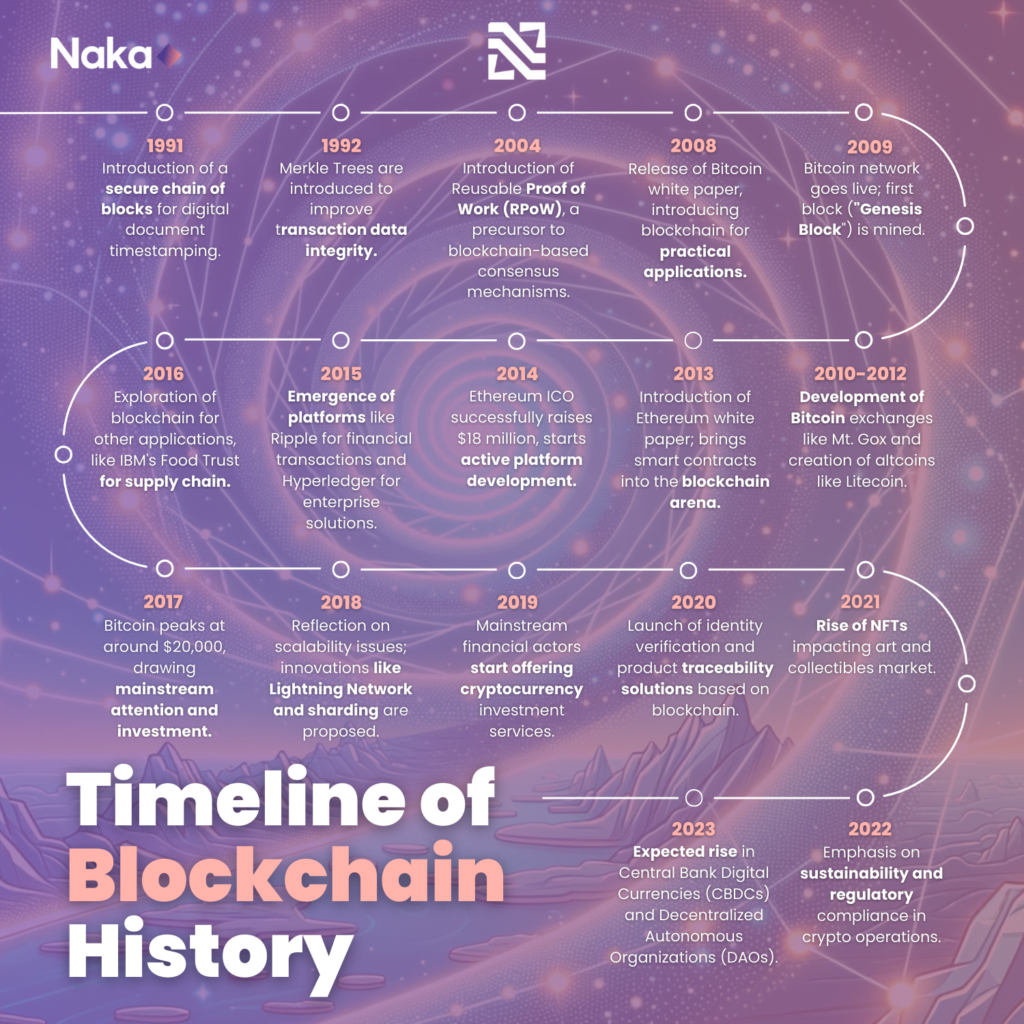“Blockchain is to Bitcoin, what the internet is to email. A big electronic system, on top of which you can build applications. Currency is just one.”
— Sally Davies, FT Technology Reporter
Discover an intellectual expedition through blockchain’s historical milestones, its metamorphosis over decades, and its growing footprint in emerging technologies like Smart Contracts and Central Bank Digital Currencies (CBDCs). From cryptographic techniques to decentralized networks and beyond, this article serves as your exhaustive primer for understanding blockchain’s exponential influence and speculative trajectory.
The Revolution Brought by Blockchain Technology
Comparison with the Inception of the Internet
When the Internet was first introduced, it revolutionized the way we communicate, transact, and even think. The blockchain technology, often considered the next Internet, has the same groundbreaking potential. Just like the Internet decentralized information, blockchain is doing the same for transactions.
The Internet started as a distributed network of data sharing, but over time, it became more centralized due to the role of major companies. In contrast, blockchain is different from traditional databases, designed to be decentralized from the ground up. It relies on a distributed ledger to record transactions, thus eliminating the need for a central authority. Here, peer-to-peer networks maintain a public ledger that everyone can trust but no single entity controls.

When and why was blockchain created? The Journey from 1991 to the Present
Stuart Haber and W. Scott Stornetta introduced the theoretical underpinnings of blockchain technology back in 1991. They proposed a cryptographically secured chain of blocks wherein each block contains a timestamp and a link to the previous block. This early form of blockchain was focused on the secure and immutable storage of documents. However, the real breakthrough came in 2008 when an unknown developer, or group of developers, using the pseudonym Satoshi Nakamoto, released a white paper titled “Bitcoin: A Peer-to-Peer Electronic Cash System.”
This white paper introduced Bitcoin, a digital currency based on blockchain. Bitcoin’s blockchain was a public, decentralized ledger of all transactions, secured through cryptographic methods. Nakamoto’s implementation of blockchain brought in the concept of “proof of work,” allowing for a distributed system of transaction verification.
The evolution of blockchain didn’t stop at Bitcoin. In 2015, Ethereum was launched, introducing the idea of smart contracts into the blockchain space. Unlike Bitcoin, which is a blockchain-based digital currency, Ethereum expanded the application of blockchain to include everything from non-centralized applications (DApps) to supply chain management. Ethereum’s proof of stake mechanism further enhanced the blockchain’s energy efficiency.
Blockchain’s Evolution: From Niche Innovation to Transformative Global Force
The history of blockchain is filled with a variety of other cryptocurrencies and blockchain projects. From Ripple aiming to streamline worldwide bank transactions, to private blockchains designed for specific enterprise solutions, the applications are nearly endless. Today, blockchain technology has transcended its original financial applications to play a pivotal role in various sectors, such as supply chain management and healthcare.
From its humble beginnings, blockchain has grown exponentially, with a plethora of cryptocurrencies, blockchain-based applications, and even blockchain games. Blockchain technology, rooted in a complex mesh of cryptography and distributed networks, has dramatically altered the landscape of digital currencies, online transactions, and data storage. With a robust blockchain architecture that combines the secured chain of blocks and the peer network, it’s undeniable that blockchain is here to stay, growing in application and impact.
The journey of blockchain, from its creation to its current state, is a testament to the transformative power of innovative technology. As blockchain continues to evolve, it is crucial to understand its history and potential to appreciate its impact fully.
Timeline of Blockchain History

The Inception of Blockchain Technology (1991 – 2008)
1991: The Birth of Blockchain Technology with Stuart Haber and W. Scott Stornetta
In 1991, computer scientists Stuart Haber and W. Scott Stornetta laid the groundwork for what would later become blockchain technology. Their work introduced a cryptographic method for securing a chain of blocks, each containing data that was time-stamped and linked to the previous block. This was an innovative way to achieve immutability and security in digital record-keeping.
1992: Introduction of Merkle Trees
The blockchain technology got a significant boost in 1992 with the introduction of Merkle Trees. This data structure allowed for more efficient and secure verification of content within blocks. It was a practical improvement that permitted the storage of multiple transactions in a single block, thereby enhancing the scalability and efficiency of the technology.
2004: Hal Finney’s Reusable Proof of Work (RPoW)
Fast forward to 2004, Hal Finney introduced the concept of Reusable Proof of Work (RPoW). This was an early form of digital cash that incorporated some of the core ideas later refined in Bitcoin. Finney’s RPoW was groundbreaking in its utilization of proof-of-work mechanisms, adding another layer of security to digital transactions.
2008: Satoshi Nakamoto and the Inception of Bitcoin
The year 2008 marked a monumental moment in the history of blockchain. An unknown individual or group of individuals, operating under the pseudonym Satoshi Nakamoto, released a white paper called “Bitcoin: A Peer-to-Peer Electronic Cash System.” This paper launched the first functional blockchain and digital currency, Bitcoin, which utilized a public, decentralized ledger for recording transactions. Nakamoto’s Bitcoin solved many issues that plagued earlier attempts at digital currencies, particularly the double-spending problem, by implementing a robust, distributed proof-of-work system.
Each of these milestones contributed to the technology’s evolution and its current diversified applications, from cryptocurrencies to smart contracts and beyond. As we continue to witness the technology’s growth, it becomes increasingly crucial to understand and appreciate these foundational moments that have made blockchain the transformative technology it is today.
2009 – 2012: The Birth of The Revolution
2009: The Early Days of Bitcoin
After the release of the groundbreaking white paper in 2008, Bitcoin’s network officially came to life on January 3, 2009. The first block, aptly named the “Genesis Block,” was mined by Satoshi Nakamoto, launching the world’s first functional digital currency. During this time, Bitcoin was not well-known and had no real-world value. However, the technology behind it, a public and cryptographically secured blockchain, set the stage for the birth of a new financial landscape.

2010 – 2012: The Genesis and Expansion of the Bitcoin Ecosystem
The years 2010 to 2012 were crucial for the expansion and acceptance of Bitcoin and blockchain technology. One of the major milestones occurred in 2010 when a developer named Laszlo Hanyecz made the first recorded purchase using Bitcoin, buying two pizzas for 10,000 Bitcoins. Around the same time, the first Bitcoin exchanges started to emerge, providing a platform for users to exchange Bitcoin for other currencies.
By 2011, the cryptocurrency landscape started to evolve, leading to the birth of new digital currencies like Litecoin and Namecoin. These cryptocurrencies not only built upon the original blockchain technology created by Nakamoto but also diversified its applications and implementation.
In 2012, the notion of blockchain technology expanded even further with the introduction of Ripple. Unlike Bitcoin’s non-centralized model, Ripple aimed to streamline real-time, cross-border transactions for banks, thereby broadening the scope of blockchain applications beyond peer-to-peer digital currency.
Throughout these formative years, the underlying blockchain technology grew in terms of security, scalability, and adaptability, making it appealing for various applications beyond cryptocurrency. As we fast forward to today, these early years serve as the cornerstone for understanding the ongoing innovations and developments in the blockchain and digital currency space.
The Rise and Struggles of Blockchain as a Future Technology (2013 – 2018)
2013: Bitcoin’s Disruption and Ethereum’s Vision
In 2013, Bitcoin garnered significant media attention as it broke the $1,000 mark for the first time. The currency’s surge highlighted its potential to disrupt traditional financial systems. Meanwhile, a young developer named Vitalik Buterin introduced a white paper for Ethereum, envisioning a blockchain platform that could execute smart contracts and distributed applications, thus diversifying the technology’s utility.
2014: Ethereum’s Evolution and the Dawn of Smart Contracts
The following year, Ethereum made strides toward its official release. A successful crowdfunding campaign in mid-2014 led to the development of this new blockchain-based platform, designed to support more complex applications and smart contracts. Ethereum’s introduction signaled a significant milestone for blockchain technology, extending its use beyond a mere transactional database.

2015: The Year of Expansion and Groundwork for Future Innovations
2015 was marked by expansion and groundwork in the blockchain ecosystem. Several startups entered the space, developing applications ranging from supply chain management to secured voting systems. Ethereum officially launched, introducing its own digital currency, Ether, and providing a practical framework for executing smart contracts.
2016: Broadening Horizons: Blockchain Beyond Cryptocurrencies
The year 2016 saw an increasingly diverse set of blockchain applications. Industries like healthcare, logistics, and finance started experimenting with blockchain for data management and transaction processing. Various forms of consensus mechanisms, such as proof of stake, were proposed to improve the scalability and efficiency of blockchain networks.
2017: Mainstream Recognition and Bitcoin’s Unprecedented Surge
Blockchain and Bitcoin penetrated the mainstream consciousness in 2017. Bitcoin’s price experienced an unprecedented surge, peaking at nearly $20,000 by the end of the year. This price explosion led to a renewed interest in blockchain technology and a surge in initial coin offerings (ICOs), as new projects sought to capitalize on the hype.
2018: A Year of Reflection and Resilience
After the euphoria of 2017, the year 2018 was a sobering period for the blockchain community. Market corrections led to a significant drop in cryptocurrency values. However, the downturn provided an opportunity for reflection and focusing on building more robust and scalable solutions. Projects like EOS and Cardano emerged, aiming to address some of the limitations of earlier blockchain platforms.
The years between 2013 and 2018 were pivotal in shaping blockchain’s trajectory. Amidst the struggles and successes, the technology matured, finding its footing not just as a revolutionary digital currency platform but as a transformative technology with diverse applications.
The Global Acceptance of Blockchain as a Potential Technology (2019 – Present)
2019: The rise of cryptocurrencies as a mainstream investment
By 2019, cryptocurrencies started receiving acceptance as a mainstream investment vehicle. Regulatory bodies began taking steps to provide a legal framework, increasing the assets’ legitimacy. Major financial institutions also started offering cryptocurrency investment options, leading to a wider reach. Notably, stablecoins like Tether and USD Coin gained traction as a bridge between traditional fiat and digital currencies, facilitating smoother transactions within the blockchain ecosystem.
2020: A Year of Blockchain Evolution Beyond Bitcoin
2020 was a defining year for blockchain, witnessing its application beyond Bitcoin and into sectors like healthcare for securing medical records and supply chain for enhancing transparency. The concept of distributed finance (DeFi) took the stage, leveraging smart contracts on platforms like Ethereum to recreate and improve upon traditional financial instruments, without a central authority. Moreover, enterprise-grade solutions such as Hyperledger Fabric saw a growth in adoption, underscoring the technology’s utility for corporate networks.
2021: The Roller-Coaster Year for Crypto Investors and the Emergence of NFTs
Last year, the crypto market experienced dramatic highs and lows. Bitcoin reached an all-time high, only to face significant corrections shortly after. Amidst the volatility, Non-Fungible Tokens (NFTs) emerged as a novel application of blockchain technology, capturing the attention of artists and collectors alike. Unique digital assets were cryptographically secured on the blockchain, revolutionizing the way we conceive art and ownership in the digital age.
2022: A Year of Lessons and Reflection in the Crypto Space
As of this year, the blockchain space has entered a phase of lessons and reflection. Regulatory scrutiny has intensified, leading to debates around user privacy and data security. At the same time, the energy consumption of blockchain networks, particularly proof-of-work systems like Bitcoin, has come under critical evaluation. These challenges have catalyzed efforts to improve scalability and sustainability, with technologies like Ethereum 2.0 and proof-of-stake mechanisms being at the forefront of this innovation.
The narrative from 2019 to the present day underscores the burgeoning acceptance and diversification of blockchain technology. It’s no longer a fringe technology but a revolutionary system that has penetrated multiple sectors, transforming traditional operations and creating unprecedented opportunities for innovation and growth.
2023: A Year of Unprecedented Developments and Opportunities in the Crypto Space
The Memecoin Phenomenon
In 2023, Memecoins like Dogecoin and Shiba Inu have grabbed the limelight, epitomizing both the whimsical and speculative nature of the crypto market. Originating as jokes, these digital currencies have garnered significant value and media attention, challenging traditional notions of asset valuation and investment. While skeptics argue that Memecoins lack fundamental value, their cultural impact and ability to mobilize community participation cannot be ignored.
Sectorial Growth and Emerging Trends
This year has also seen blockchain technology making significant inroads into various sectors beyond finance. Supply chain management, for example, is increasingly utilizing blockchain for traceability and authenticity verification. Similarly, the gaming industry is embracing blockchain, particularly through the use of NFTs and decentralized finance (DeFi) mechanisms to create new monetization strategies and user engagement models.
Crypto Adoption: A Surge in Global Crypto Owners
Global crypto ownership has seen a sharp increase in 2023. As blockchain technology has become more robust and user-friendly, more people worldwide have started to engage with cryptocurrencies, either as an investment, a transactional currency, or a means to participate in non-centralized applications. Major financial institutions have also rolled out crypto-based services, providing easier on-ramps for the general population to enter the crypto space.
The developments of 2023 highlight the multifaceted growth and adoption of blockchain technology and cryptocurrencies. Memecoins have showcased the unpredictable yet engaging nature of the crypto ecosystem, various industries are recognizing the potential applications of blockchain, and a growing global user base signifies the technology’s move toward mainstream adoption.
The Future of Crypto: A Detailed Forecast
Artificial Intelligence (AI): The Silent Revolution
Artificial Intelligence and blockchain technology are increasingly intertwined. AI algorithms are being integrated into blockchain networks for optimized decision-making, fraud detection, and smart contracts. This amalgamation allows for predictive analytics that can help in resource allocation, thereby improving blockchain’s overall efficiency.
Central Bank Digital Currencies (CBDCs): A Harmonious Blend of Tradition and Innovation
As blockchain gains legitimacy, central banks around the world are considering the implementation of Central Bank Digital Currencies. By leveraging blockchain technology, CBDCs aim to combine the best of both worlds: the stability and regulatory oversight of traditional fiat currency with the speed, efficiency, and reduced transaction costs associated with blockchain.
Layer 2 Solutions: The Next Frontier in Blockchain Scalability
With Ethereum and Bitcoin suffering from scalability issues, Layer 2 solutions like Lightning Network for Bitcoin and rollups for Ethereum are becoming increasingly important. These provide faster and more cost-efficient transaction methods while ensuring that the foundational layer remains secure and decentralized.
Next-Generation NFTs: The Expanding Horizon
NFTs are evolving beyond art and collectibles into forms like “smart NFTs” that have built-in functionalities. For instance, a smart NFT could include code that makes the item evolve over time or interact with its environment. This opens up possibilities for use-cases in gaming, real estate, and digital identity, among others.
Web4: The Dawn of a User-Centric Digital Ecosystem
Blockchain is poised to play a key role in the evolution of the internet into a more user-centric, decentralized entity—often referred to as Web4. It promises to provide users more control over their data while making monetization more equitable among content creators and consumers.
Security Tokens: The New Frontier in Asset Management
Security tokens, backed by real-world assets and governed by legal regulations, are set to reshape the landscape of asset management and investments. Unlike traditional securities, these tokens utilize blockchain technology for transparent, efficient transactions and record-keeping.
Decentralized Finance (DeFi): The Mainstreaming of a Revolutionary Concept
DeFi, initially a niche concept within the crypto community, is set to become mainstream. With more secure, user-friendly interfaces and products that offer better yields than traditional financial instruments, DeFi platforms are attracting a new wave of users who are keen to explore financial products outside of the traditional banking ecosystem.
In summary, the future of crypto is not just limited to currency or asset management, but extends to a structural transformation of various sectors through the integration of blockchain technology, AI, and other advancements. The rise of CBDCs, Layer 2 solutions, and next-generation NFTs all point toward an increasingly versatile and user-centric digital ecosystem.
Conclusion
- Enduring Legacy: The journey from the introduction of blockchain technology to its current applications has been monumental.
- Diverse Applications: Blockchain’s potential is not limited to cryptocurrencies but extends to various sectors like finance, supply chain, and digital identity.
- Future Outlook: Developments like AI integration, CBDCs, and Layer 2 solutions are poised to further propel blockchain into mainstream acceptance.
“Blockchain technology has moved beyond its genesis as a revolutionary payment system and now shows promise for uses ranging from transparent business transactions to monitoring supply chains.”
– Harvard Business Review
The narrative of blockchain has never been confined to a single application or time frame. Its rapid evolution is a testament to its disruptive potential, and its adaptability ensures its role in shaping the digital future. It’s not just a technology; it’s a revolution.





